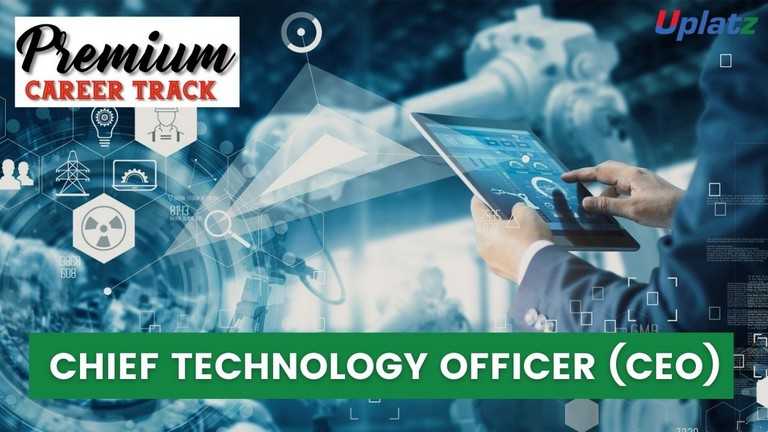Career Accelerator - Head of Technology
Master Technology Leadership, Strategy & Innovation to Drive Digital TransformationPreview Career Accelerator - Head of Technology course
Price Match Guarantee Full Lifetime Access Access on any Device Technical Support Secure Checkout Course Completion Certificate 100% Started a new career
BUY THIS COURSE (
100% Started a new career
BUY THIS COURSE (GBP 32 GBP 99 )-
 85% Got a pay increase and promotion
85% Got a pay increase and promotion
Students also bought -
-

- Premium Career Track - Chief Technology Officer (CTO)
- 1000 Hours
- GBP 39
- 5214 Learners
-

- Career Path - IT Consultant
- 200 Hours
- GBP 32
- 5851 Learners
-

- Next.js
- 6 Hours
- GBP 12
- 876 Learners

About the Course
The Career Accelerator – Head of Technology program by Uplatz is a premier self-paced online learning experience designed for experienced technology professionals ready to ascend into executive technology leadership roles. Whether you’re an aspiring Chief Technology Officer (CTO), VP of Engineering, or a senior developer or architect aiming to step into broader leadership responsibilities, this course offers the comprehensive foundation, strategic acumen, and hands-on perspective you need to lead complex, high-impact technology initiatives in today’s digital-first world.
Technology is at the heart of business transformation. In a time where innovation, agility, and scalability are critical for success, technical leaders must evolve into business-oriented visionaries. They are expected not just to manage systems or teams but to guide entire organizations through digital innovation, scalable architecture design, and future-forward technology decisions. The Career Accelerator – Head of Technology program is tailored to help you meet these demands with confidence, clarity, and capability.
This course delivers an immersive learning journey that blends strategic leadership training, real-world case studies, and executive-level guidance across topics such as technology governance, cloud architecture, product engineering leadership, technical debt management, IT budgeting, team scaling, and cross-functional alignment. With a strong emphasis on business-technology integration, you will also learn how to translate technical opportunities into business value, manage stakeholders, and influence board-level decisions.
Delivered in a flexible self-paced format, this course allows you to learn on your own schedule while still gaining deep insights into what it takes to lead in a senior technology position. All learning content is structured into logical, easy-to-follow modules supported by expert-led video lectures, interactive tools, and strategic assignments. At the end of the course, you will receive a Course Completion Certificate from Uplatz, verifying your readiness for executive-level technology leadership roles.
Why This Course Matters
The role of a technology leader today is no longer limited to overseeing IT infrastructure or engineering teams. As digital transformation accelerates, modern organizations require technology executives who can think like business strategists, lead like product owners, and deliver like systems architects.
This course will equip you with:
- A holistic understanding of technology strategy and architecture.
- Proven techniques for leading and scaling high-performance engineering teams.
- The ability to align tech roadmaps with business vision and customer needs.
- Tools to drive innovation, manage technical debt, and lead complex transformations.
- Communication and stakeholder management skills essential for executive influence.
Whether you're leading cloud migration, driving DevOps culture, or aligning a company’s digital stack with customer experience goals, this course ensures you're not just a tech expert—but a technology leader capable of shaping the future of your organization.
Who Should Take This Course?
This course is ideal for:
- Senior Engineers and Technical Architects aiming to move into leadership positions.
- Engineering Managers, Product Leaders, and Tech Leads transitioning to executive roles.
- IT Directors or Department Heads managing large-scale infrastructure or software initiatives.
- Entrepreneurs or startup CTOs looking to sharpen strategic leadership capabilities.
- Consultants and Program Managers who work at the intersection of business and technology.
If you're ready to take the next big step in your career and lead technology efforts that drive business success, this course is designed specifically for you.
How to Use This Course
The Career Accelerator – Head of Technology course is designed for strategic, applied learning. To make the most of your experience, it’s important to approach it as a progressive, career-building journey rather than a traditional training program. Here’s a guide to help you navigate and benefit from the course effectively:
- Start with the Orientation Module
Begin with the introduction to understand the course layout, learning objectives, and how each module builds on the previous one. This helps you mentally prepare for what’s ahead and plan your learning time effectively. - Follow the Learning Path Sequentially
Each topic has been carefully structured to take you from foundational principles to advanced strategic thinking. It’s recommended to go through the content in the given order, as later sections often build on earlier lessons. - Engage with Expert-Led Videos
Watch the video lectures attentively. Pause, rewind, and take notes to absorb the core ideas. Most sessions include real-world case insights and leadership principles that you can apply directly in your professional role. - Practice with Case Studies
Throughout the course, you will encounter practical case studies that mirror real-world leadership challenges. These are your sandbox for applying theory to practice—use them to build your decision-making confidence. - Reflect and Internalize
After each module, take time to reflect. How does the material apply to your current role? How would you lead differently using these concepts? This reflection is essential for transforming knowledge into wisdom. - Complete Strategic Assignments
Assignments are built to mirror the responsibilities of a Head of Technology. They include activities like drafting a technology roadmap, assessing team maturity, or preparing a board-level presentation. Approach them seriously—they can be valuable additions to your leadership portfolio. - Use the Downloadable Tools
The course includes leadership templates, strategic frameworks, and architecture planning checklists. Customize these tools for your projects to gain practical utility from your learning. - Document Your Growth
Keep a personal leadership journal or digital portfolio as you progress. Documenting your insights and reflections helps track growth and prepares you for interviews, performance reviews, or internal promotions. - Engage with the Community (if available)
If you have access to a discussion forum or alumni network, connect with peers. Sharing perspectives and solving challenges collaboratively can deepen your understanding and expand your professional network. - Complete the Capstone Project
Toward the end of the course, apply everything you’ve learned in a comprehensive capstone project—such as leading a mock digital transformation initiative or building a future-ready technology plan for a hypothetical company. This not only consolidates your learning but also provides a strong demonstration of your capabilities. - Earn Your Certification
After completing all modules and assessments, download your Course Completion Certificate from Uplatz. Share it on LinkedIn or include it in your resume to boost credibility with potential employers or current stakeholders. - Revisit Content as Needed
Technology leadership is a dynamic field. Return to the materials whenever you face a new challenge or need to reinforce a concept. The course is your ongoing professional toolkit.
By the end of this course, you will have transformed your technical expertise into strategic leadership capacity—enabling you to confidently lead cross-functional teams, drive enterprise technology vision, and innovate at scale. Whether you’re leading software development, cloud adoption, or digital innovation, this course prepares you to be not just a participant in transformation, but its architect.
Course/Topic - Course access through Google Drive
-
Google Drive
-
Google Drive
By the end of this course, you will be able to:
- Define a Technology Vision – Align IT strategy with business objectives.
- Design Scalable Enterprise Architecture – Optimize systems for performance, security, and cost.
- Lead Digital Transformation – Implement AI, cloud, and DevOps at scale.
- Manage Stakeholders – Communicate effectively with executives, boards, and investors.
- Navigate Emerging Tech Trends – Leverage AI, blockchain, and IoT for competitive advantage.
- Build High-Performing Teams – Foster innovation, agility, and engineering excellence.
- Drive Innovation & R&D – Evaluate and adopt cutting-edge technologies.
- Optimize Tech Budgets & ROI – Justify investments and measure impact.
- Ensure Cybersecurity & Compliance – Mitigate risks in enterprise IT.
- Prepare for CTO & VP-Level Roles – Transition from technical expert to strategic leader.
Career Accelerator - Head of Technology Course Syllabus
Module 1: Technology Strategy & Leadership
- Crafting a tech roadmap for business growth
- Balancing innovation vs. operational stability
- Case Study: How Netflix scales its tech infrastructure
Lab: Develop a 5-year technology strategy for a Fortune 500 company
Module 2: Enterprise Architecture & Scalability
- Microservices vs. monoliths
- Cloud migration (AWS, Azure, GCP)
- High-availability systems & disaster recovery
Lab: Redesigning a legacy system for scalability
Module 3: Stakeholder & Executive Management
- Presenting tech proposals to CEOs & boards
- Managing vendor relationships
- Aligning IT with marketing, sales, and finance
Lab: Simulated boardroom pitch for a $10M AI initiative
Module 4: Emerging Technologies & Innovation
- AI/ML adoption strategies
- Blockchain for enterprise
- Edge computing & 5G applications
Lab: Building a proof-of-concept for an AI-driven product
Module 5: Team Leadership & Culture
- Hiring & retaining top engineering talent
- Remote & hybrid team management
- Creating a culture of innovation
Capstone Project:
- Lead a digital transformation case study
- Present to a panel of industry experts
Upon completing the Head of Technology course, you’ll receive a Course Completion Certificate from Uplatz, recognizing your expertise in technology leadership, strategy, and innovation.
This certification:
- Validates your readiness for CTO, VP of Engineering, and Head of IT roles
- Prepares you for industry-recognized leadership certifications
- Enhances your credibility for executive tech positions
Graduates of this program are prepared for senior leadership roles, including:
- Chief Technology Officer (CTO)
- VP of Engineering
- Director of Technology
- Head of IT & Digital Transformation
- Technology Strategy Consultant
Industries Hiring Tech Leaders:
- Tech (FAANG, startups, SaaS)
- Finance (FinTech, banking)
- Healthcare (HealthTech, AI diagnostics)
- Retail & E-commerce (Omnichannel tech, AI personalization)
1. How do you align technology strategy with business goals?
By mapping tech initiatives to revenue growth, cost savings, and customer experience KPIs.
2. Describe your approach to scaling a high-traffic platform.
Use microservices, CDNs, auto-scaling, and database sharding.
3. How would you present a tech investment proposal to a non-technical CEO?
Focus on ROI, competitive advantage, and risk mitigation in simple terms.
4. What emerging tech trends are most impactful for enterprises?
AI automation, hybrid cloud, and cybersecurity AI.
5. How do you foster innovation in engineering teams?Hackathons, 20% innovation time, and cross-functional R&D pods.
6. What’s your experience with cloud migration?
Led AWS/GCP migrations with a focus on cost optimization.
7. How do you handle technical debt in fast-growing companies?
Balance feature development with quarterly "tech debt sprints."
8. What’s your leadership style for remote engineering teams?
Async communication, clear OKRs, and virtual bonding activities.
9. How do you evaluate build-vs-buy decisions?
Assess cost, time-to-market, and long-term maintenance.
10. What metrics do you track for engineering productivity?Deployment frequency, lead time, MTTR, and team happiness.









